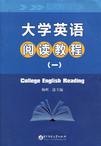大学英语阅读教程
2009-7
华中科技大学出版社
杨辉 编
145
本教程共分四册,第一册围绕“运用语言技能理解文章”这一层面的阅读技能展开训练;第二册重点解析和训练“辨别和理解中心思想和重要细节”这一层面的阅读技能;第三册训练“运用专门的阅读技能(略读、查读)”这一层面的阅读技能;第四册提高难度,把前三册的阅读技能贯穿于其中。每册分为8个单元,各单元由同一题材的2篇文章、生词注释、有关文化背景介绍、练习等组成。为了配合学生参加大学英语四、六级考试,每个单元增加阅读训练部分,由3篇配有选择练习题的小短文组成;同时在主课文的练习中,增加了汉译英练习。 本套教程的编写体现了如下特点。 (1)本教程由具有丰富的教学经验的大学英语教师分工协作、集体编写而成,具有很强的专业性。 (2)本教程在编写过程中充分吸收我国在外语教学方面长期积累起来的行之有效的经验和方法,取各家之长,兼容并蓄,能适应多种英语教学的要求。 (3)本教程旨在通过教师的“精讲”和学生的“多练”来提高学生学习的主动性、积极性和创造性。 (4)本教程选用当代英语常见语体或文体的典型样本作为素材,内容新颖,搜选范围主要是近五年来英美国家出版的图书、报纸、杂志或最新的网络文章,涵盖教育、科技、政治、经济和文化等各个方面,阅读文章素材具有时代性、可读性、文化教育性和针对性。 (5)本教程练习题型的设计均按照最新的大学英语四、六级考试标准和难度进行。文章后附设了6种题型:一是快速阅读(包括是非判断题和句子填空题);二是阅读理解(多项选择题);三是篇章理解(选词填空题),依据阅读文章的内容,编出一篇小短文,留出10个空,给出15个词供读者进行选择填空;四是简答题,一般用问句形式命题,要求读者作简短回答;五是翻译题,共5个句子,句中一部分已用英文给出,要求学生根据全句意思将汉语部分译成英语;六是讨论题,对文章内容提出2个问题,供学生讨论。各题型的题量适当,这样可以帮助学生逐步熟悉考试形式,更好地为四、六级考试作准备。
Unit 1 Growing Up Part 1 Reading Text Part 2 Reading Skill Part 3 Reading Practice Part 4 Home ReadingUnit 2 Friendship Part 1 Reading Text Part 2 Reading Skill Part 3 Reading Practice Part 4 Home ReadingUnit 3 Understanding Science Part 1 Reading Text Part 2 Reading Skill Part 3 Reading Practice Part 4 Home ReadingUnit 4 American Dream Part 1 Reading Text Part 2 Reading Skill Part 3 Reading Practice Part 4 Home ReadingUnit 5 Romance Part 1 Reading Text Part 2 Reading Skill Part 3 Reading Practice Part 4 Home ReadingUnit 6 Animal Intelligence Part 1 Reading Text Part 2 Reading Skill Part 3 Reading Practice Part 4 Home ReadingUnit 7 Emergency Part 1 Reading Text Part 2 Reading Skill Part 3 Reading Practice Part 4 Home ReadingUnit 8 Coping with an Educational Problem Part 1 Reading Text Part 2 Reading Skill Part 3 Reading Practice Part 4 Home Reading
Rormie White, of the Miracles singing group, heard Stevie and promptly took him down to his recording company, Motown Records. "Give him an audition." Ronnie said. They did, all the top people at Motown got together to hear a little blind boy who wasnt even ten years old yet. At first, they were being nice. Poor kid. They didnt want to hurt his feelings. Then they heard Stevie sing and play, and nobody said "poor kid" anymore. They were too busy congratulating themselves on finding a youngster who could be the musical talent of the decade. "Hes a wonder boy." Somebody said as they watched little Stevie dart from one instrument to the next, playing each one with ease. "Wonder," somebody else said, "Little Stevie Wonder." The new name stuck and Stevie Morris became Little Stevie Wonder. He had his first hit when he was twelve years old. It was called Fingertips and it was a smash. Over the following years, Little Stevie Wonder became one of the top recording artists at Motown, producing one hit after another. But as he grew into adulthood, Stevie began to get tired of the way the Motown Company controlled all aspects of his career. He wanted to write and produce his own songs, but the Motown Company thought it was unwise to change a winning formula. When he turned 21, Stevie finally got his freedom. Against Motowns wishes he started exploring: he made records that combined gospel, rock and roll, and jazz and which used African and Latin American rhythms. To the record companys surprise, Stevies new albums such as Music of Mine and Innervisions were even more popular than his early ones. Stevie Wonder had become a mature man and an independent musical artist. Just after this success, however, tragedy struck. In August of 1973, Stevie was involved in a serious car accident. For nearly a week he lay in a coma, unable to speak or walk. "We dont know when hell be out of danger," the doctor said. Everyone waited and prayed. Suddenly, it didnt matter that Stevie was a musical genius or that he had conquered blindness and poverty. All he had left was his faith and strong will.
